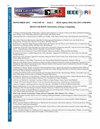α-kappa-mu衰减信道上相干数字调制方案的简化 SEP 近似值
IF 1.3
4区 工程技术
Q3 COMPUTER SCIENCE, INFORMATION SYSTEMS
引用次数: 0
摘要
在本文中,我们提出了在流行的阿尔法-卡帕-穆衰减信道上众多数字调制方案的误差概率表达式的新颖、简化但严密的近似值。借助高斯 Q 函数的适当近似和泰勒级数展开,我们简化了繁琐的积分,这对简化各种数字调制方案的符号误差概率 (SEP) 等性能评估指标起到了关键作用。这有助于设计具有成本效益的接收器,使整个系统具有经济可行性。我们借助相对误差进一步说明了所提出的 SEP 表达式的准确性。本文还重点介绍了截断误差(及其上限)。我们还计算了截断误差上限的相对误差,以进一步证明所提积分的准确性。此外,本文还提供了积分的渐近表达式,为大信噪比无线通信系统的分集阶提供了思路。本文章由计算机程序翻译,如有差异,请以英文原文为准。
Simplified SEP Approximations of Coherent Digital Modulation Schemes over alpha-kappa-mu Fading Channel
In this paper, we propose novel, simplified yet tight approximations of the error probability expressions of numerous digital modulation schemes over a popular alpha-kappa-mu fading channel. With the help of a suitable approximation of the Gaussian Q-function and utilization of Taylor's series expansion, we facilitate the cumbersome integrals which play a key role in simplification of the performance evaluation metrics like symbol error probability (SEP) of various digital modulation schemes. This facilitates cost effective receiver's design making the overall system economically viable. We further illustrate the accuracy of the proposed SEP expressions with the help of the relative error. An insight on the truncation error (and its upper bound) is also highlighted in this paper. We also compute the relative error in the upper bound of the truncation error to further justify the accuracy of the proposed integrals. Moreover, the asymptotic expressions for the integrals are also provided which gives an idea regarding diversity order of the wireless communication systems for large signal to noise ratios.
求助全文
通过发布文献求助,成功后即可免费获取论文全文。
去求助
来源期刊

IEEE Latin America Transactions
COMPUTER SCIENCE, INFORMATION SYSTEMS-ENGINEERING, ELECTRICAL & ELECTRONIC
CiteScore
3.50
自引率
7.70%
发文量
192
审稿时长
3-8 weeks
期刊介绍:
IEEE Latin America Transactions (IEEE LATAM) is an interdisciplinary journal focused on the dissemination of original and quality research papers / review articles in Spanish and Portuguese of emerging topics in three main areas: Computing, Electric Energy and Electronics. Some of the sub-areas of the journal are, but not limited to: Automatic control, communications, instrumentation, artificial intelligence, power and industrial electronics, fault diagnosis and detection, transportation electrification, internet of things, electrical machines, circuits and systems, biomedicine and biomedical / haptic applications, secure communications, robotics, sensors and actuators, computer networks, smart grids, among others.
 求助内容:
求助内容: 应助结果提醒方式:
应助结果提醒方式:


